- Home
- Galaxies
Galaxies in the Universe - the different types and they how were formed
There are billions and billions of galaxies in the Universe. All contain loads of stars orbiting a galactic centre.
Many galaxies in the Universe are so-called "dwarf galaxies", implying that they're quite small. Well, yes, but only when compared to other, massive galaxies. Our own Milky Way is somewhere between the two and is around 100,000 light years across.
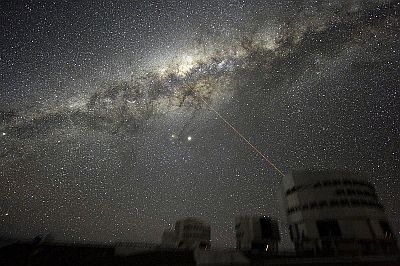
source
So, in much the same way as our Sun is an average star, our Milky Way is an average galaxy. Dwarf galaxies are much smaller, with maybe only 10 million stars, but at the other end of the scale, there are huge supergalaxies, containing up to 100 trillion stars. The Milky Way has something like 250 billion.
Galaxies typically consist of stars, star remnants, gas and dust. About 90% of the total mass, however, is made up of a mysterious substance called "dark matter", which is invisible and undetectable. This is covered in detail in a different section of the site, but it is thought that, without the presence of dark matter, the force of gravity within galaxies and, indeed, throughout the Universe, wouldn't behave the way it does.
Yes, the force of gravity has a lot to answer for in the Universe. It is responsible for making it the way it is. It holds the planets of our solar system in place around the Sun; it holds stars in orbit around the galactic centre; it causes galaxies to group together in local groups. It was even gravity that initiated the formation of the visible Universe in the first place, in the aftermath of the Big Bang.
The First Galaxies in the Universe
Although details of the Big Bang are dealt with elsewhere, we'll have to consider it briefly here. Suffice it to say, between 300,000 and 150 million years after the Big Bang, there was an era known as the "Dark Ages". Take this literally, because there were not yet any stars or galaxies - the young Universe was dark, or "opaque". In fact, the dominant substance at this time was dark matter.
How the first "proto-galaxies" were formed is still under debate. What is certain is that our old friend gravity played a part. The dark age Universe contained, as well as dark matter, a sort of "photon soup". A photon is a particle of radiation, which may be visible light or other electromagnetic type. These photons had, at the time, a neutral electric charge, rendering them invisible. What was required was something to cause them to be ionized, in other words, become electrically charged - and visible.
Now, this photon soup was not entirely uniform. There were slightly more dense bits here and there. Gravity seized the moment and started pulling these together. As they became more dense, intense bursts of radiation were emitted, effectively ionizing the Universe. In this new state, the continued gravitational collapse eventually transformed the soup into visible clumps, making small globular clusters. These merged to make larger proto-galaxies. Soon, with the further action of gravity, nuclear fusion became possible and the first stars ignited within these objects.
These first stars were supermassive, however and, therefore, short-lived. But their brief existence ended with a huge explosion, leaving suitable debris to facilitate the creation of more and more mainstream stars, turning the proto-galaxy into a galaxy.
That's one theory, anyway.
Types of Galaxy in the Universe
At the most basic level, there are three distinct types of galaxy: elliptical, spiral and irregular. Spirals can, in turn, be either barred or not. The barred version is the most common spiral galaxy and our own Milky Way falls into this category.
In 1926, the famous astronomer Edwin Hubble proposed a "morphological classification scheme" for galaxies, subdividing the two main types. This is illustrated by this chart:
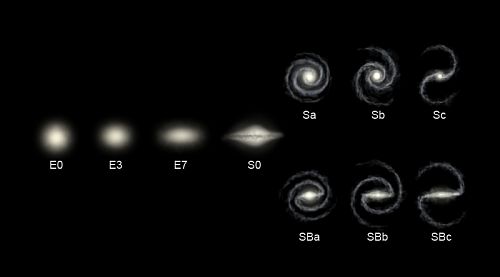
It's pretty self explanatory. The elliptical ones "E" are followed by a number according to how spherical or flat the galaxy is. The spirals "S" or barred spirals "SB" are followed by a, b or c, according to how tight the spirals are. The galaxy designated "S0", in the centre of the diagram is a type called "lenticular". This is a sort of link between the ellipticals and the spirals and consists of a central bulge, surrounded by a disk, but with no discernible spirals.
Needless to say, there are galaxies out there that don't fall comfortably into the Hubble categories. Here's a list of all the different types, with links to pages, telling you more about them (eventually). The Milky Way has been given its own page.
- Milky Way
- Elliptical
- Spiral
- Starburst
- Ring
- Lenticular
- Perculiar
- Irregular
- Dwarf
Larger Galactic Structures
Throughout the Universe, you will find small numbers of galaxies existing in relatively close proximity to each other. This sort of collection is called a "group". Our own Milky Way is part of a set of at least 54 galaxies, including Andromeda and this is termed the Local Group.
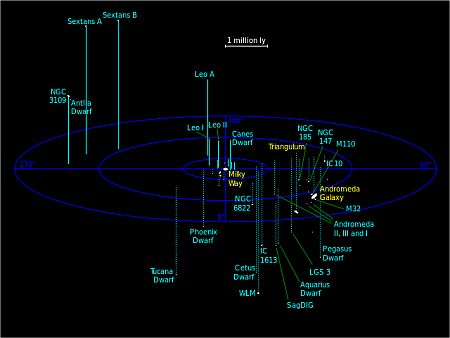
Image: Richard Powell
The outer boundaries of this Local Group span one million light years. The Milky Way and Andromeda galaxies are the two most massive within it.
Next up, size-wise, is the galactic cluster. The only difference between this and a group is the number of galaxies within it. They are the third largest known structures in the Universe and may contain as many as 100-1,000 galaxies.
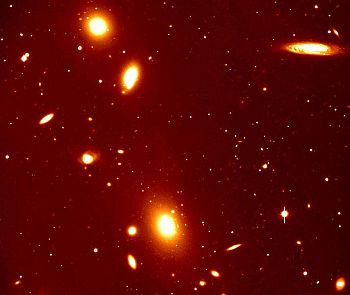
Credit: ESO
The second largest structures ever observed are superclusters - collections of clusters. Our Local Group is part of the Virgo Supercluster, a huge object spanning some 110 million light years. In addition to the Local Group, it contains over 100 groups and clusters.
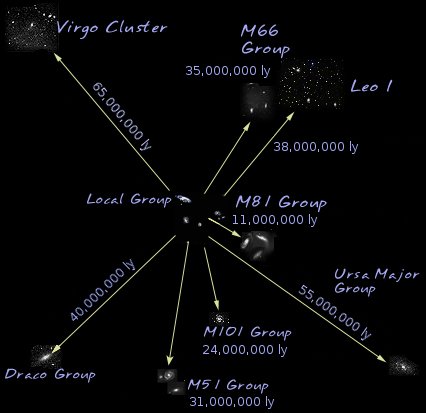
The Virgo Supercluster, showing some of the major structures within it
Now we come to the top of the list - structures that are a fraction of the size of the whole Universe itself. These are known variously as galaxy filaments, supercluster complexes, or great walls.
The largest four such structures begin with the one imaginatively called the CfA2 Great Wall, or the Coma Wall. This unbelievably huge object, about 200 million light years from Earth, has been observed by astronomers as being 500 million light years long, 300 million light years wide and 16 million light years thick. It may be even bigger, but any further observation is obscured by the Milky Way, which, quite simply, gets in the way.
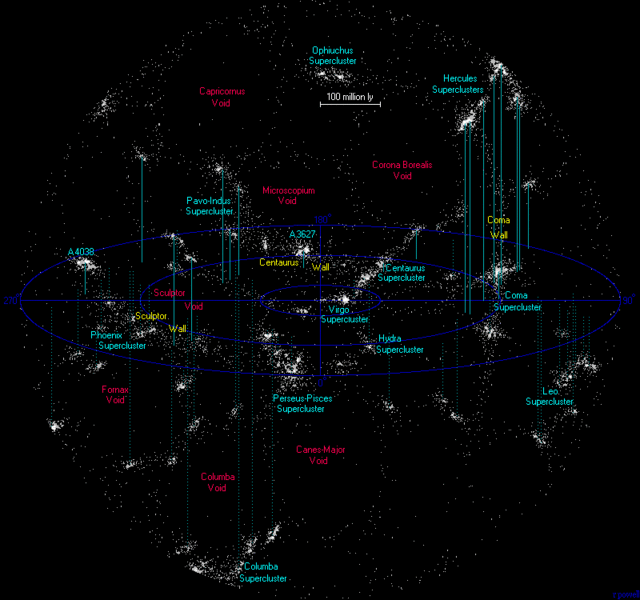
Image: Richard Powell
This great wall can be seen in the above diagram, as can the next on the list, number three in size, the Pisces-Cetus Supercluster Complex, in the centre of the image. This includes the Local Group, the one that contains our Milky Way. It is one billion light years long and 150 million light years wide.
This is superceded by what was thought to be the largest structure in the Universe, the Sloan Great Wall. Discovered in 2003, it is 1.38 billion light years long, which is one sixtieth of the total diameter of the whole Universe.
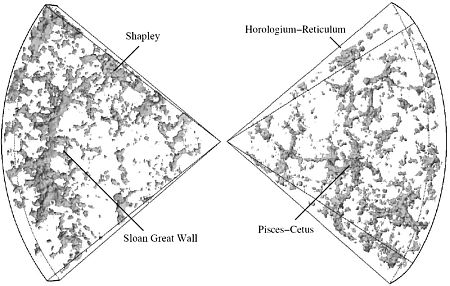
You can see, in the above graphic, representing the nearby observable Universe, just how big this is. Astronomers thought they'd found the ultimate large object. However, in November 2013, an experiment to map gamma-ray bursts in the distant universe uncovered the latest record holder for the largest structure in the Universe.
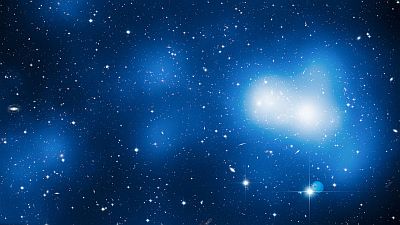
Credit: NASA, ESA, Harald Eberling, Jean-Paul Kneib
The Hercules-Corona Borealis Great Wall is a breathtaking 10 billion light years long, which is more than one-tenth the diameter of the observable Universe. Its discovery has raised questions as to the validity of our current model of the Universe. As it is situated some 10 billion light years away, that's how far back in time we're seeing it. The trouble is, that would mean it was fully formed only some 3.8 billion years after the Big Bang - and that's simply not enough time for it to have happened. So, the Hercules-Corona Borealis Great Wall is not only the largest known structure in the Universe, it is also an enigma that challenges our existing theories.
Colliding Galaxies
Galaxies existing as part of groups or clusters are often close enough to their neighbours for gravity to play a part, drawing them even closer. It is not uncommon for a collision to occur. This may result in the two galaxies merging, or for them simply to pass through one another, then continue on their way.
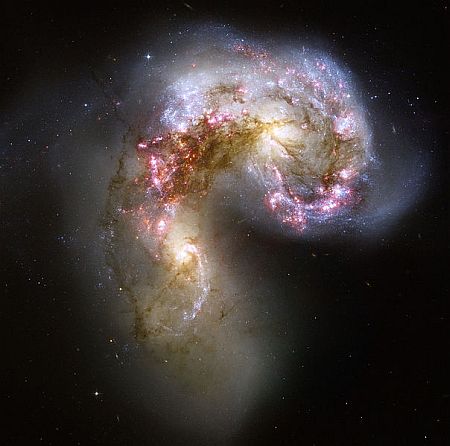
The Antennae Galaxies, in the process of merging
Our Milky Way galaxy and the neighbouring Andromeda galaxy are currently approaching each other and will eventually collide sometime within the next several billion years. At the moment, the Milky Way is actually swallowing up the Sagittarius Dwarf Elliptical Galaxy and the Canis Major Dwarf Galaxy.





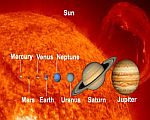



Facebook Comments
Have your say about what you just read! Leave me a comment in the box below.